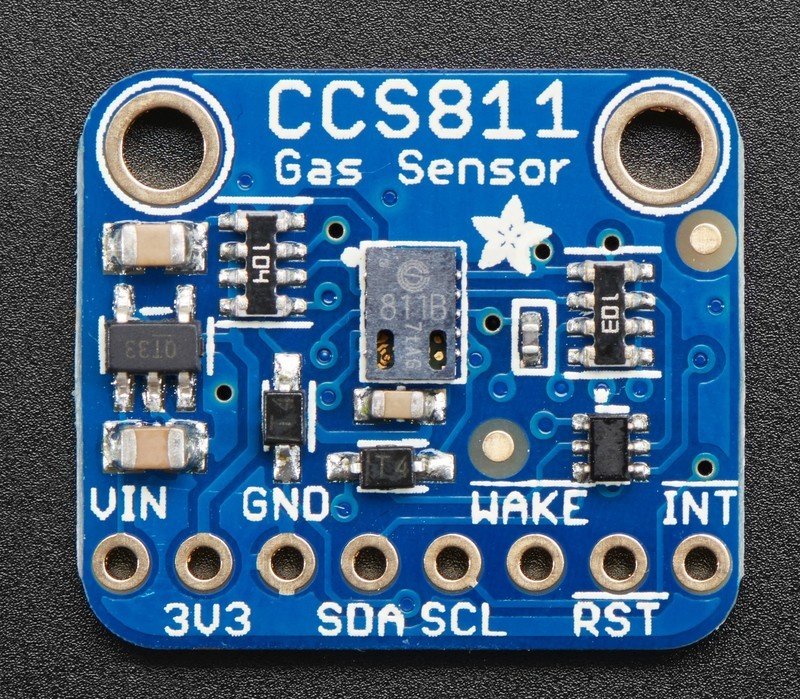CCS811 is an air quality sensor that senses different gasses present in the air we breathe. It has a metal oxide (MOX) sensor and a small microcontroller. The MOX sensor detects the volatile organic compounds and the microcontroller has an ADC converter that reads the analog values and an I²C interface to read from. This sensor has multiple drive modes that take measurements after every 1s, 10s, the 60s or even 250ms.
CCS811 Pinout
Pin Description
The CCS811 sensor module consists of eight pins in which three are power pins. SDA and SCL are logic pins while the remaining three (WAKE, RST, INT) are control pins.
Vin Pin
The breakout board consists of a voltage regulator, sensor and some other components. The operating voltage of the sensor is 3.3 V and the DC voltage range for a regulator is 3 to 5volts. supply power to the board. Its value should be the same as that of a microcontroller. The voltage regulator integrated inside the chip converts this value to 3.3V so that the sensor can perform its operation.
3V3 Output Regulator
It is the output of a regulator which is 3.3V.
GND: Ground pin
SPI Communication Pins
- SDA
It is the I²C data line of an internal microcontroller. A pullup resistor of 10K is connected at this pin to pull it up to DC voltage.
- SCL
It is the I²C clock line of an internal microcontroller. Just like the SDA pin, these pins also have a pullup resistor for level shifting.
Control Pins
- WAKE
It is an active low input which sleeps the sensor when pulled high or connected to a voltage supply. If you want to communicate through the sensor then connect this pin to the ground.
- RST
The reset pin is active low. To reset the IC, pull this pin to the ground.
- INT
INT is an active low input pin which generates interrupt requests. It determines the interrupt state and indicates when a new reading is ready.
CCS811 Features
- The module requires voltage supply in a range of 3.3V to 5V for operation.
- It has an integrated microcontroller, an I2c digital interface, and a voltage regulator.
- It measures the concentration of volatile organic compounds and equivalent carbon dioxide concentration in air and outputs its value.
- The measuring range for equivalent Cis 400 to 8192ppm.
- The measuring range for TVOC is 0 to 1187ppb.
- In addition to TVOC and eC, it also detects Organic acids, aldehydes, ketones, amines aromatic and aliphatic hydrocarbons present in the air.
- It has multiple drive modes that take measurements after every 1s, 10s, 60s or 250ms.
- The module also contains an NTC thermistor which measures temperature.
- It has a very fast cycle time.
Where to use it?
It is an ultra-low-power, highly compact and economical digital sensor module which is compatible with Arduino and CircuitPython. You can use this sensor for monitoring indoor air quality. It can be used with CircuitPython board, computer, Arduino or any other microcontroller that requires 5V DC supply for operation. Due to its extended battery life, you can use it in portable devices like smartwatches, etc.
How to use CCS811?
Although it can be used with other microcontrollers also, but we are explaining the connections of this module with Arduino to understand its working. If you are using this sensor for the first time after purchasing it, run the sensor for 48 hours to achieve a stable operation. During the first 48 hours, the change in resistance is higher due to which its sensitivity changes. After that run it 20 minutes in any desired mode before using it.
Interfacing with Arduino
The wiring connections are simple.
- Connect Vin to the 5V power supply as the Arduino also operates on 5V.
- Also, connect the GND pin of the module to the GND pin of Arduino.
- After that, connect the SCL pin and SDA pin to the I2C clock SCL and SDA data pin of Arduino. And ground the WAKE pin.
CCS811 Applications
It monitors air quality by detecting and measuring the concentration of different gases in indoor air. Some uses of this module are in:
- Smartphones
- Portable devices and wearables
- Home and Building automation


